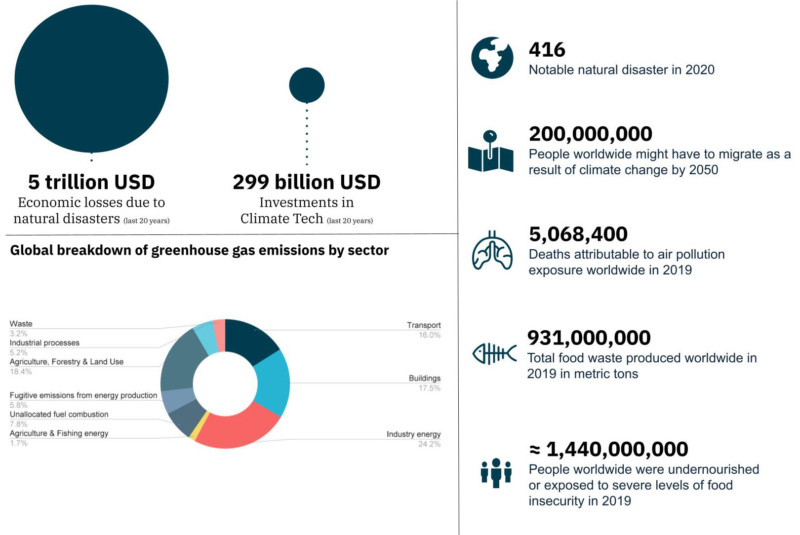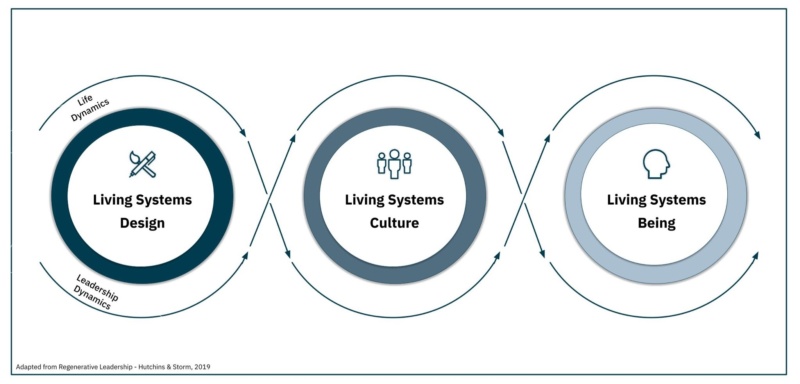Regenerative Leadership – How to lead into a sustainable future

Navigating the last two years has been an unparalleled experience, to say the least. Today’s life is constantly changing and in a volatile, uncertain, complex, and ambiguous world (in short VUCA) it is increasingly difficult to plan for the future. Of course, changes were always present throughout humanity’s history, but rapidly advancing technologies, social inequality, and the current COVID-19 pandemic confront all of us with ever-evolving challenges.
Additionally, we have hit record levels in global temperature rises, catastrophes related to natural disasters, and scientists warn us that four out of nine life-supporting systems that we as humans rely on this earth are already pushed into a space that might lead to irreversible consequences in our ecosystems (for more info check the Planetary Boundaries). And we can already feel it: in 2020 alone, 416 natural disaster events were recorded, with a cumulative economic loss of all-natural disasters since 2000 reaching a total of 5 trillion USD globally (that’s 12 zeros). People around the world face the consequences of these developments. The World Bank estimates that climate change could force more than 200 million people worldwide to migrate by 2050. This would mean that we would have to relocate the entire population of Germany, France, and Spain in the next twenty-five years. Moreover, global carbon dioxide and other greenhouse gas emissions reached a record high of 51 billion tons per year, trapping heat in the atmosphere and pushing the speed of climate change further ahead. The following chart provides an overview of some effects of climate change.

The good news
We understand the negative implications of our behavior on our life-supporting, global ecosystems. And we are capable of turning the issues we are seeing into one of the biggest opportunities of humanity’s existence. All we need are people leading this transition.
Leadership is crucial for this change because we need people to envision a future that is fundamentally based on sustainable systems, and to convince others to join working on this vision. Two points are important there:
- It is leadership, not management: There is an amount of uncertainty involved when walking into an unknown direction that defines a leader, not only the coordination of given resources
- The vision is key: “Vision without action is useless. But action with vision does not know where to go or why to go there. Vision is absolutely necessary to guide and motivate action. More than that, vision, when widely shared and firmly kept in sight, brings into being new systems.” – Donella Meadows
What we start to understand on a broader, global level is that the way we have organized societal structures is too extractive and puts too much pressure on the resources around us. The incredible innovations from the industrial revolutions we have partaken in over the last two hundred years have given us tremendous wealth, health improvements, and comfort beyond anything we have seen before in human history. Now that we are starting to see the negative implications of the take-make-waste approach that we have used until now, it is time to lead by example and take the next level in our development: Seeing and acknowledging the VUCA world in which we find ourselves in a multitude of completely intertwined global systems. Essentially, we have three options to deal with the challenges on our planet:
- Do nothing and see what happens
- Optimize existing systems which might delay negative effects
- Reshape our systems by simultaneously improving existing structures while embracing and testing disruptive alternatives
Rethinking and innovation are key within this, and we as individuals can all be innovators in our respective fields, taking responsibility to envision new ways of designing and living within our locally and globally connected spaces. This brings us to Regenerative Leadership.
Leading the way into a regenerative future
Regenerative Leadership describes a new leadership model that empowers humans to move “society toward life-affirming futures” (Hutchins & Storm, 2019). While “life-affirming” might sound a little bit fluffy and flower-power-like, let’s quickly recap:
- The climate crisis is a direct negative effect of our overuse of carbon extracted from the earth and the systematic degradation of our natural environment
- We are risking irreversible tipping points that might leave our agriculture devastated, cities flooded, and huge immigration movements from the global South into the North
Consequently, something in the way we organize our systems, and our individual lives doesn’t seem to be totally “life-affirming”. There is a substantial risk that if we don’t adapt parts of our behavior and the systematic build-up of industry and ecosystems, we might face a strong decrease in quality of life for ourselves, our children, and grandchildren. Acknowledging our increased understanding of the interdependencies in global supply-chains should therefore result in an adaptation of our underlying mental models.
So what does “regenerative” essentially describe? How is it different from sustainability? The Oxford dictionary describes sustainability as “maintaining a certain rate or level”, whereas regeneration goes into proactively re-building what is lost. Regeneration goes a step further than sustainability, looking into ways where negative effects are not only prevented but positive traits are added.
Think about an analogy in health: we can either treat symptoms of diseases or prevent the symptoms from emerging in the first place (something that is called salutogenesis and could be described as preventive care). Daniel Christian Wahl, one of the pioneers in the field of regeneration emphasizes that:
“(…) if the basic intention behind all human design was salutogenesis, we would be able to facilitate a local and global shift towards sustainability.“, furthermore arguing that: “Salutogenic design aims to facilitate the emergence of health at and across all scales of the whole. It recognizes the inextricable link between human, ecosystem and planetary health.”
Preventing bad symptoms from developing in the first place and using the concept of (planetary) health and nature-positive design as the starting point sounds like a promising way to finding the right balance on the magnificent blue marble we live on.
Bringing it back to us as individuals – this is more or less what Regenerative Leadership proposes. The underlying question is how we can behave in a way that enables us as humans to be healthy and predominantly happy in our lives, and how we can take care of the ecosystems surrounding us in order to continue thriving. Again, leadership in this context describes taking proactive responsibility towards a shared vision, and guiding and empowering people around to follow into this proposed and shared future.
Developing this kind of vision can be done using different methods. One classic approach e.g. is asking the question: How do we individually envision a perfect future in 30 years, and what can we do today to make achieving this future more likely? While this concept of reverse engineering is commonly used in foresight and innovation departments, translating its intention of how to proactively work towards a better future into a leadership framework is a bit trickier.
Laura Storm and Giles Hutchins have designed a conceptual framework that supports this kind of narrative: The Regenerative Leadership DNA.
Their model consists of:
- Three building blocks: Living Systems Design, Living Systems Culture, and Living Systems Being
- Two continuously evolving strains that connect and support the three Living Systems blocks: Leadership dynamics and Life dynamics, and
- Seven principles that are summarized as the Logic of Life

The building blocks
Living Systems Design relates to the way we build and design products and processes. One prominent example is the practice of biomimicry. Taking nature as inspiration can lead to very interesting innovations. One of the most prominent ones is the lotus-effect on glasses. The leaves of a lotus plant have a structure that forces water-drops to roll off, taking dirt on the leaves with them. Essentially, a self-cleaning process. This has been observed and consequently added as a new feature to high-quality glasses. Similar biomimicry-inspired ideas have been used in the design of high-speed trains, or the reduction of friction on marine vessels. Nature is looking back on 3.8 billion years of adaptation and evolution, a vast amount of knowledge that we can leverage to rethink the way we design our products, processes, and services.
The second block, Living Systems Culture is all about how we interact in bigger groups and what guiding principles can be used to drive collaboration on different levels in society. One of the key points here is the use of systems thinking and acknowledging the fluidity of our constantly interacting ecosystems. If we acknowledge that we can’t control the VUCA world around us, how do we interact with our surroundings then? One concept, TheoryU, explores how to let the future emerge by using “presencing”, a combination of being present and sensing what opportunities might arise in front of us. Instead of trying to control the unknown, this way of relating to the world around us proposes to enable extensive collaboration and flexibility in interaction with other individuals and the systems around us.
Finally, Living Systems Being narrows further down on this, describing what attributes are important as an individual to navigate a regenerative environment, drawing on research from behavioral psychology, ancient theories, and neurology. The core of this is a mindset based on presence, patience, playfulness, and taking off-times in our day-to-day – an antidote to the fast-speeding, growth, and burn-out-prone lifestyle that has gotten more and more common in the last years. A regenerative leader focuses on interbeing instead – “[…] a shift in the perception of self and other that lies at the heart of co-creating regenerative human cultures and a sustainable human presence on Earth.” (Wahl, 2016)
In combination, these three blocks provide a starting point and inspiration on how to design our world in a regenerative way, how to interact culturally on different levels, and how to show up as individuals to support the former two consciously. These blocks are connected and supported by “Life-” and “Leadership dynamics“.
The Evolving Strains
Life dynamics describe spiral patterns that flow through the Regenerative Leadership DNA, called convergence and divergence. If convergence and divergence overlap that leads to emergence. Yes, that is abstract. Let’s clarify with a specific example from the technology space. If you have a smartphone that has a calendar, camera, telephone, and to-do list function on it you combine different previously separate products. This is called convergence. If you would get rid of your smartphone and buy all of these things separately again this would be called divergence. Convergence is thus the combination of different ideas, aligning and structuring them into one, whereas divergence focuses on exploring separate ideas. Sometimes there are points where there is the perfect match between exploratory chaos and stabilizing order (think about yin and yang), and something great emerges. For your smartphone, this might mean an optimal amount of useful apps, but no physical pocket knife included (that would be too much convergence of different functions). This process of exploring and combining goes on continuously, and it is on leaders to understand, foster, and utilize these dynamics, and to spot when they meet and something useful emerges.
Leadership dynamics focuses on the individual leader’s perspective on how to deal with the immediate surroundings. We can differentiate between an inward- and an outward-looking component: self-awareness, and systemic awareness. Self-awareness describes how self-reflective a leader is in regards to his or her thoughts, habits, resulting behavior, and potential blind spots. In contrast, we have systemic awareness, the ability to understand and shape bigger networks, flows, and relationships within the systems surrounding us. If we combine both perspectives, understanding who we are and how the systems around us function, we can consciously steer towards visions that go beyond our biased perspectives and benefit society and nature as a whole.
The Principles of the Logic of Life

As the final part of their model, Storm and Hutchins define seven underlying principles that are the core of how life on Earth naturally operates. Called the Logic of Life, they start with one simple overarching idea: “Life creates conditions conducive to life”. When an apple falls down a tree, it decomposes at some point, becomes soil, and thus nutrients again that can be taken up by the surrounding flora and fauna. It is an ongoing cycle that cascades through all of our natural ecosystems. Our surroundings are ever-changing, relational, synergistic, and diverse. Nature is based on interconnected living systems, continuously changing and deeply anchored in collaboration – principles that we as humans can use as inspiration to tackle our current global challenges and to build systems that mirror this evolutionary intelligence.
Conclusion
So how can this new framework help us to navigate the uncertainties of our rapidly changing environment? Fundamentally, it supports each of us to be a leader on the changes ahead and create opportunities by:
- Understanding ourselves and the systems around us, and
- Taking responsibility for driving the vision we believe in
We understand the global patterns and the effects of our behavior on the ecosystems around us. We have the tools, and the capabilities to build a world that is self-sustaining while providing us with all the comfort we might be looking for. What is needed is our proactive work on understanding our systems, where we can do better, and start implementing smart solutions that e.g. mimic what nature has already been doing for the last 3.8 billion years on this planet. For this, the Regenerative Leadership DNA provides concrete concepts and a shared language to create a world where we can thrive in the long run.
Supporting this, the area of sustainability-related investments and social entrepreneurship has been increasing tremendously. Since 2011, over 1.800 climate tech startups have been founded and over 6.700 venture capital deals have been closed globally. Additionally, the climate tech market represents a vast and sprawling opportunity that currently amounts to a 2,5 USD trillion market. People feel drawn to this narrative of a world where individuals feel empowered and purposeful on their path throughout life, working curiously and creatively on nature-supporting ideas and innovations. So let us start being regenerative leaders and focus on building a world that is thriving in its complexity – with us as vital, conscious, and regenerative participants in it.


